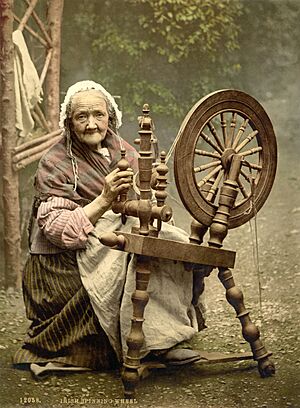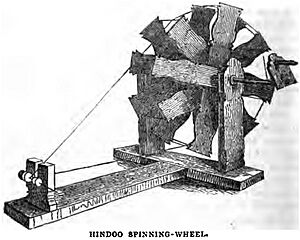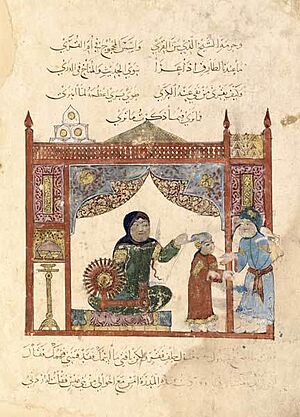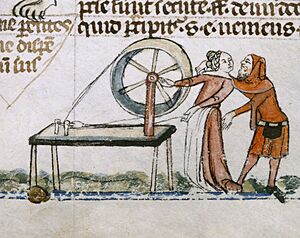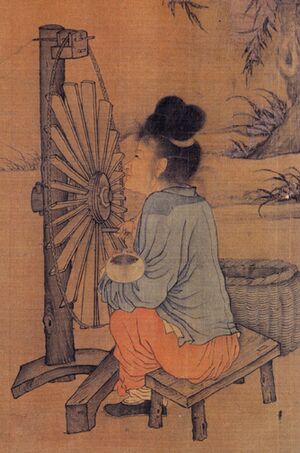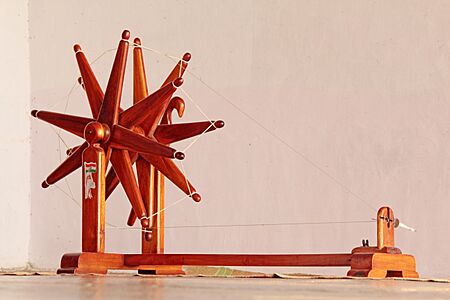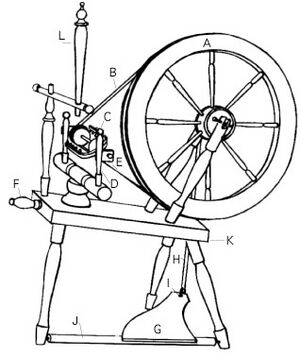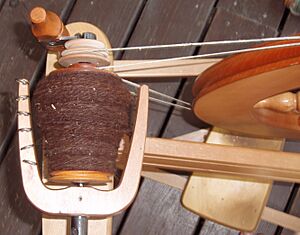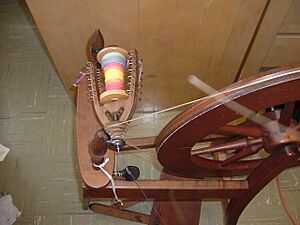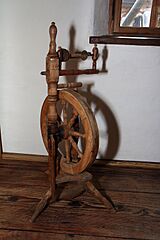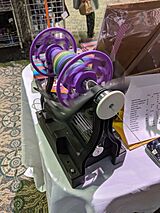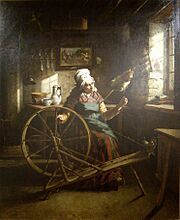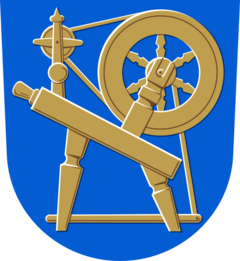W:Spinning wheel facts for kids
A spinning wheel is a machine used to make thread or yarn from different types of fibers. Before the Industrial Revolution, it was a very important tool for making cotton textiles. It helped lead to the invention of bigger machines like the spinning jenny and the spinning frame, which later took its place.
Contents
How a Spinning Wheel Works
Making yarn starts with taking a bunch of fibers and pulling some out. Then, you twist them into a basic string shape. Spinners keep pulling and twisting to make the yarn longer and control how thick it is. Thousands of years ago, people did this by hand onto a stick called a spindle. This was a very slow process.
The wheel part of a spinning wheel doesn't replace the spindle. Instead, it helps to twist the thread automatically. This means you don't have to twist it by hand all the time. The size of the wheel also helps you control how much twist goes into the thread. The finished thread still ends up on a spindle, just like before the wheel was invented.
At first, people turned the wheel by hand or foot. Later, simple parts were added so a person could push a pedal. This kept the wheel turning at a steady speed. This pedal system was the biggest improvement to the spinning wheel before the 1700s.
History of the Spinning Wheel
Historians disagree on exactly when and where the spinning wheel was invented. Some think it might have started in ancient China around 1090 AD. Others believe it was invented in India as early as 500-1000 AD. There is also evidence that it was known in the Middle East by 1030 AD. The clearest drawing of a spinning wheel is from Baghdad in 1237.
The spinning wheel came to Europe from the Middle East by the 1200s. The first European drawing of it is from around 1280. In France, people continued to use the older spindle and distaff method until the mid-1700s.
The spinning wheel replaced the older way of spinning by hand with a spindle. The first step to making it a machine was putting the spindle flat. A large, hand-turned wheel then spun it with a cord. The great wheel is an example of this. With this wheel, you held the fiber in one hand and slowly turned the wheel with the other. By holding the fiber at a slight angle, it would twist. The spun yarn was then wound onto the spindle.
In 1533, someone in Brunswick, Germany, supposedly added a treadle. This allowed the spinner to turn the spindle with one foot, leaving both hands free to spin. Leonardo da Vinci drew a picture of the "flyer." This part twists the yarn before winding it onto the spindle. By the 1500s, a treadle wheel with a flyer was common. It was called the Saxony wheel or flax wheel. This invention made spinning much faster because you didn't have to stop spinning to wind up the yarn.
Some Chinese technical books from the 1300s describe an automatic spinning wheel powered by water. Similar machines didn't appear in Europe until the 1700s. However, this water-powered wheel was forgotten in China by the 1600s. This happened as fiber production changed from hemp to cotton.
Before the Industrial Revolution, it took at least five spinners to provide enough yarn for one weaver. In 1738, Lewis Paul and John Wyatt patented a machine called the Roller Spinning machine. It used rollers that moved at different speeds to make yarn more even. This helped speed up spinning. Later, in 1771, Richard Arkwright used waterwheels to power machines for making cotton cloth. His invention was called the water frame.
Today, modern spinning machines use motors to spin the spindle. They also have automatic ways to pull out fibers. These machines can work many spindles at once, much faster than before. Even newer technologies use friction or air jets to make yarn even quicker.
Types of Spinning Wheels
There are many different kinds of spinning wheels:
- The great wheel (also called a walking wheel or wool wheel) is used for quickly spinning soft, fluffy wool yarns.
- The flax wheel is a special wheel used with a distaff to spin flax fibers for making linen.
- Saxony and upright wheels are all-purpose wheels driven by a foot pedal. They can spin both wool and other types of yarns.
- The charkha is a type of spinning wheel from Asia.
To spin yarn on any wheel, the fibers must be prepared. Except for silk, which can be spun directly from cocoons, fibers usually need to be combed or carded. At the very least, dirt or plant bits must be removed. Most handspinners start with a soft, aligned mass of fibers to make even yarn.
Charkha
The tabletop or floor charkha is one of the oldest types of spinning wheels. It works like the great wheel. One hand turns a drive wheel, while the other hand spins yarn off the spindle tip. Both the floor charkha and the great wheel look very similar. With both, you have to stop spinning to wind the yarn onto the spindle.
The word charkha comes from a Persian word meaning "wheel." It is also linked to the Sanskrit word for "circle." The charkha was both a tool and a symbol for the Indian independence movement. This small, portable, hand-cranked wheel is great for spinning cotton and other fine fibers. It can also spin other fibers. Charkhas come in different sizes, from as small as a book to as large as a briefcase, or even a floor model.
Leaders of India's Freedom Struggle encouraged people to use the charkha. They hoped it would help India become self-sufficient and independent. Because of this, the charkha became a symbol of the independence movement. It was even included on earlier versions of the Flag of India.
-
A charkha used by Mahatma Gandhi.
Great Wheel
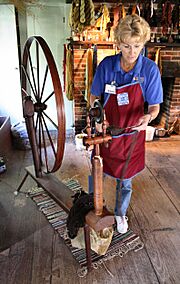
The great wheel was one of the first types of spinning wheels. You hold the fiber in your left hand and slowly turn the wheel with your right. Yarn is spun on a great wheel using a technique called long-draw spinning. This method mostly uses one hand, leaving the other free to turn the wheel. The great wheel is usually used for short fibers like cotton and wool.
A great wheel is usually over 5 feet (1.5 meters) tall. The large drive wheel turns a much smaller spindle. The spindle spins many times for each turn of the drive wheel. The yarn is spun off the tip of the spindle and then stored on it. To start, a piece of waste yarn (a leader) is tied to the spindle and spiraled up to the tip. Then, the spinner overlaps some fiber with the leader, holding both gently. They slowly turn the drive wheel clockwise with their right hand. At the same time, they walk backward, pulling the fiber away from the spindle at an angle. The left hand must control the tension to make even yarn. Once enough yarn is made, the spinner turns the wheel backward a bit to unwind the spiral. Then, they turn it clockwise again to wind the new yarn onto the spindle.
Treadle Wheel
This type of wheel is powered by the spinner's foot instead of their hand or a motor. The spinner sits and pumps a foot pedal (treadle). This turns the drive wheel using a crank and a connecting rod. This leaves both hands free to prepare the fibers. This is important for the short draw spinning technique, often used on these wheels. Most modern treadle wheels use a flyer-and-bobbin system. This system twists the yarn and winds it onto a spool at the same time. These wheels can have one or two pedals. This is a personal choice and doesn't change how the wheel works.
Double Drive
The double drive wheel gets its name because its drive band goes around the spinning wheel twice. The drive band turns both the flyer (the horseshoe-shaped wood piece around the bobbin) and the bobbin. Because the bobbin's whorl (the round part the band runs on) is smaller than the flyer's, the bobbin turns a little faster. Both the flyer and bobbin twist the yarn. The difference in speed winds the yarn onto the bobbin when the spinner loosens the tension. When the spinner keeps the yarn tight, the bobbin and flyer spin together to add twist to the yarn.
The drive band on a double drive wheel is usually made from strong cotton or hemp yarn that doesn't stretch.
Single Drive
A single drive wheel set up in Scotch tension has one drive band. This band connects the drive wheel to the flyer. The spinning drive wheel turns the flyer and, through friction, the bobbin. A short tension band, or brake band, adds drag to the bobbin. This means that when the spinner loosens their hold on the new yarn, the bobbin and flyer spin differently. This winds the yarn onto the bobbin. A tighter tension band pulls the yarn onto the bobbin more strongly. A looser band pulls it more gently. Generally, the tension band is tighter for spinning thicker yarn or yarn with less twist. It's looser for thinner yarn or yarn with more twist.
In Irish tension, or 'bobbin lead,' the drive band turns the bobbin, and the tension band brakes the flyer. Some wheels can be set up in either single drive way, while others only one. Some wheels can even be set up as either double drive or single drive.
Upright Style
When the spindle or flyer is located above the wheel, not to the side, it's called an upright wheel or castle wheel. These wheels are often smaller, making them easier to store and move. Some upright wheels can even fold up small enough to fit in airport carry-on bags. An Irish castle wheel is a type of upright wheel where the flyer is below the drive wheel.
Electric Spinning Wheel
An electric spinning wheel, or e-spinner, uses an electric motor instead of a foot pedal. Some need to be plugged into an outlet, while others can run on a rechargeable battery. Most e-spinners are smaller, easier to carry, and quieter than traditional wheels. One good thing about e-spinners is that you don't have to coordinate your feet with your hands. This can make it easier to learn to spin than on a traditional treadle wheel. E-spinners are also good for people who have trouble using a foot pedal or keeping a steady speed.
Friction Drive
This type of foot-pedal wheel doesn't use a drive band. Instead, the flyer is directly turned by friction. A rubber ring touches the flat surface of a solid drive wheel at a right angle. One example from New Zealand is from 1918. A few other models using this method have been made since 1970. These wheels are very compact and less likely to get dirty outdoors than wheels with drive bands. However, they are quite rare.
Why Spinning Wheels Are Important
The spinning wheel made making thread much faster, more than 10 times faster! Historian Lynn Townsend White Jr. said the spinning wheel helped increase the supply of rags. This led to cheaper paper, which then helped in the development of printing.
It was essential for the cotton textile industry before the Industrial Revolution. It set the stage for later machines like the spinning jenny and spinning frame. These machines eventually replaced the spinning wheel during the Industrial Revolution. The spinning wheel was a key step before the spinning jenny, which was widely used during the Industrial Revolution. The spinning jenny was basically an improved version of the spinning wheel.
Spinning Wheels in Culture
Because spinning wheels were so common, they appear in art, books, and other parts of many cultures around the world. In South Asia, the spinning wheel became a strong political symbol.
Political Symbolism
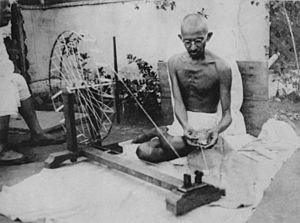
Starting in 1931, the traditional spinning wheel became the main symbol on the flag of the Provisional Government of Free India.
Mahatma Gandhi's simple clothing and his dedication to hand spinning were key parts of his beliefs. He chose to wear a traditional loincloth to reject Western culture. It also showed his connection to the poor people of India. His personal choice became a powerful political message. He urged his wealthier followers to do the same. He asked them to get rid of their European-style clothes and proudly return to their old, pre-colonial culture.
Gandhi said that spinning thread in the traditional way also had practical benefits. He believed it would help India's poor rural areas become economically independent and survive. This focus on traditional cloth making was part of a larger movement called swadeshi movement. This movement aimed to boycott all British goods. Gandhi explained that returning to spinning didn't mean rejecting all modern technology. Instead, it meant rejecting the unfair economic and political system that controlled textile making. Gandhi said, "Machinery in the past has made us dependent on England. The only way we can get rid of this dependence is to boycott all goods made by machinery. This is why we have made it the patriotic duty of every Indian to spin his own cotton and weave his own cloth."
Literature and Folk Tales
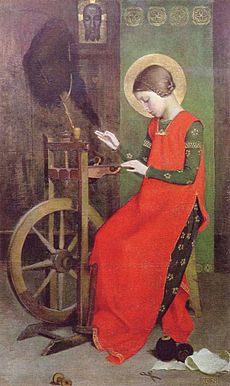
The Golden Spinning Wheel is a Czech poem by Karel Jaromír Erben. It was part of his famous collection of folk ballads, Kytice.
Rumpelstiltskin, a tale collected by the Brothers Grimm, is about a woman who must spin straw into gold. If she fails, she will be executed. Rumpelstiltskin helps her, but he wants her first child. She manages to keep her child by guessing his name.
Another folk tale with spinning wheels is Sleeping Beauty. In this classic fairy tale, the main character pricks her hand on the poisoned spindle of a spinning wheel. She then falls into a deep sleep because of a wicked fairy's curse. There are many versions of this story. In some, the spindle is part of a spinning wheel.
It's interesting that a traditional spindle doesn't have a sharp end that could prick a finger. Despite this, the story of Sleeping Beauty pricking her finger on a spindle continues. She has never seen one before because they were banned from the kingdom to prevent the curse.
Walt Disney's 1959 animated film of Sleeping Beauty shows a Saxony or flax wheel. In this version, Princess Rose pricks her finger on the distaff, which holds the plant fiber. In Tchaikovsky's ballet The Sleeping Beauty, only a spindle is used. This is closer to the original French story.
Spinning wheels are also important in the Scottish folk tale Habitrot and the German tales The Three Spinners and The Twelve Huntsmen.
Louisa May Alcott, known for Little Women, wrote a collection of short stories called Spinning-Wheel Stories. These stories weren't about spinning wheels themselves. Instead, they were meant to be read while doing the somewhat boring task of using a spinning wheel.
Music
Classical and Symphonic
In 1814, Franz Schubert wrote "Gretchen am Spinnrade." This is a song for piano and voice based on a poem from Goethe's Faust. The piano music shows Gretchen's worry as she spins on a spinning wheel, waiting for her love to return.
Antonín Dvořák composed The Golden Spinning Wheel. This is a symphonic poem based on the folk ballad from Kytice by Karel Jaromír Erben.
Camille Saint-Saëns wrote Le Rouet d'Omphale (Omphale's Spinning Wheel). This symphonic poem is about the classical story of Omphale and Heracles.
A popular piano piece for students is Albert Ellmenreich's Spinnleidchen (Spinning Song) from 1863. It has a repeating musical pattern that sounds like a spinning wheel.
Folk and Ballad
The Spinning Wheel is also the name of a classic Irish folk song by John Francis Waller.
A traditional Irish folk song, Túirne Mháire, praises the spinning wheel. It is widely taught in junior schools in Ireland.
Sun Charkhe Di Mithi Mithi Kook is a Sufi song in the Punjabi language. It is inspired by the traditional spinning wheel. It's a song from a lover who remembers their beloved with the sound of each spin of their Charkha.
Opera
Spinning wheels are also important in the Wagner opera The Flying Dutchman. The second act starts with local girls sitting at their wheels and singing about spinning.
Gilbert and Sullivan's The Yeomen of the Guard begins with a single character singing while spinning at her wheel. This was the first of their operettas not to start with a group of singers.
Art
Spinning wheels can be found in art all over the world. They are shown as everyday tools or in a more symbolic way. For example, in India, they can have political meanings.
See also
- Ashoka Chakra
- Spindle (textiles)
- Spinner's weasel
- Spinning (textiles)
- Spinning jenny
- National Charkha Museum
- Trinjan


